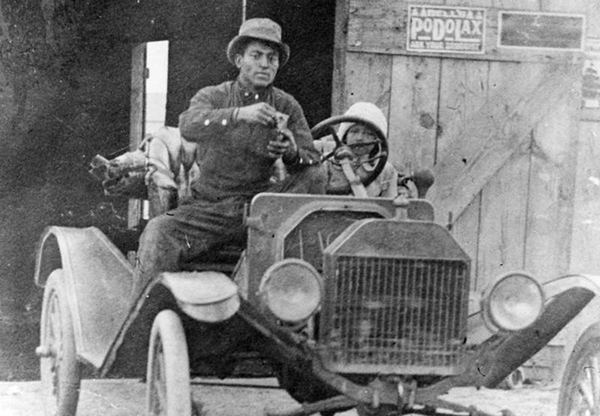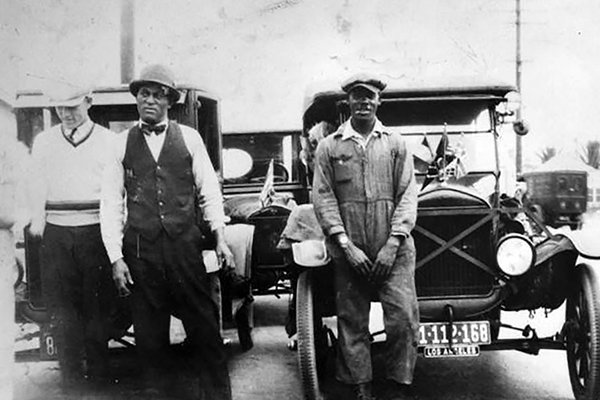Deckard, a successful Black businessman from Texas, moved to Los Angeles in 1922 and quickly drew the ire of the local White residents.


By Jason Lewis
Before Verna Deckard passed away in 1998 at the age of 91 years old, she told several extraordinary stories about her family’s move to Los Angeles from Tatum, Texas. One of those stories was about how her father, Jule Deckard, dealt with anti-Black attempts of intimidation and violence from White people in Texas and in California.
As Verna’s story goes, Jule was a successful Black businessman in Tatum, which is a small town in East Texas, south of Longview and Marshall. Jule was a mechanic, and he owned the only auto repair shop in the area, so he was getting all of the business. The White residents of Tatum were upset to see a Black man doing so well financially, so they devised a plan to destroy his livelihood.

A few White men went to Jule’s shop and hit him with a sledgehammer. It appeared that their plan was to kidnap him. Those plots usually ended with a hanging. With the help of Jule’s son and a shop employee, they fought the White men off.
Jule opened a second shop in Terrell, Texas. In another anti-Black act of violence, that shop was burned down by White residents. Jule had family living in Los Angeles, and in 1922 they convinced him to make the move.
In 1925 Jule purchased a house for $3,200 on 58th Place, between Central Avenue and Hooper Avenue, just south of Slauson Avenue. The problem was that the home was in a White neighborhood at that time. The White residents were not happy to see a Black family moving into their neighborhood, so a few of them met with Jule. In a more subtle attempt to run him and his family out of the neighborhood than he experienced in Texas, they offered to buy the house from him. Jule agreed to sell the house to them… for $4,200, a higher price than he purchased the house for. The White men balked at Jule’s asking price, refusing to give a Black man a profit.
The next day a mob of 50 White men showed up at Jule’s house, but he was at work at the auto repair shop that he owned on Central Avenue and 26th Street. So the mob told his wife Eula and daughter Verna, who was pregnant with Arthur Lewis Jr. at the time, that they had to be out of the house by sunrise. Verna’s husband Arthur Lewis Sr. was also away from the house, at work, on this day. After the mob left, Eula called the Los Angeles County sheriffs, but it took them a few hours to arrive. Verna suspected that it took them so long to come because some of the sheriffs were a part of the mob.
When the sheriffs finally arrived, Jule had made it home, and he had his rifle out. The sheriffs entered the home, and before asking any questions, they approached Jule and snatched the rifle from him. Standing up for his rights, Jule immediately snatched the rifle back and said that if he were home when the mob came, there would have been dead bodies in front of his house.
The next morning at sunrise, nobody from the mob showed up to force Jule and his family out of the house. It appears that they received word about what Jule said to the sheriffs about shooting people with his rifle, so they were scared off. That day, Jule’s uncle, who was fair skinned and could pass for being White, walked around the neighborhood snatching White men up by the collar, and demanded to know if they were a part of the mob. The White men all frighteningly said no.
After this encounter with Jule, word spread around about him, and the White people said, according to Verna, that Jule was a “bad nigger who was not to be messed with.”
Jule went on to successfully run his businesses in the Central Avenue area of Los Angeles, and Verna found a lot of success buying and selling real estate in South Los Angeles. She was a part of the fight that allowed Black people to move west of the Central Avenue area. She eventually had her home built in West Adams by renowned architect James H. Garrott, who was a Black architect who was described as a "pivotal black avant garde modernist of the 1940s era. Verna spent her final years living in Leimert Park. Arthur, Sr. died in 1928 of tuberculosis. As for Arthur, Jr., after graduating from Jefferson High School and receiving a degree in business from UCLA, he went on to become a very successful businessman in Los Angeles.











